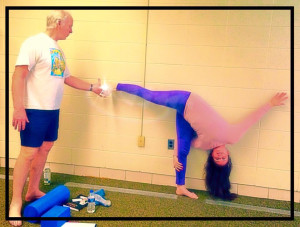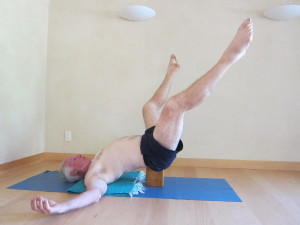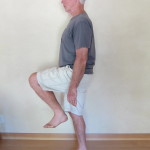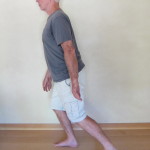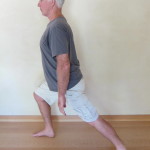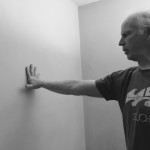In two previous posts we covered three key sutras from Patanjali’s Samadhi Pada, and the three practices of Kriya Yoga introduced at the beginning of the Sadhana Pada. In this, the third and final post in this trinity of trinities, we will dive into Patanjali’s three sutras on asana or posture, II-46 – II-48.
But first I would like to emphasize the point that ultimately there is only one practice. We find many variations for differing situations and types of students, but they all bring us back to the primary spiritual goal; to stay centered in the heart, present to whatever arises moment to moment, expressing as much kindness to ourselves and others as possible. Easy to say the words, very, very difficult to live.
The heart is the seat of compassion and love. It is the link between the finite and the infinite, a portal from the world of time and space into the mystery of creation. It is the center of blessing and being blessed. But the heart is also almost always heavily armored and defended, as the painful memories of loss, shame, and the many slings and arrows of outrageous fortune that have befallen us are stored here. Thus, as Pema Chodron often mentions in her dharma talks, we are all far more familiar with the feeling of the heart closing down, than opening up.
 “When I was about six years old I received the essential bodhichitta teaching from an old woman sitting in the sun. I was walking by her house one day feeling lonely, unloved and mad, kicking anything I could find. Laughing, she said to me, “Little girl, don’t you go letting life harden your heart.”
“When I was about six years old I received the essential bodhichitta teaching from an old woman sitting in the sun. I was walking by her house one day feeling lonely, unloved and mad, kicking anything I could find. Laughing, she said to me, “Little girl, don’t you go letting life harden your heart.”
Right there, I received this pith instruction: we can let the circumstances of our lives harden us so that we become increasingly resentful and afraid, or we can let them soften us and make us kinder and more open to what scares us. We always have this choice.”
The openhearted state, known as bodhicitta, is the goal of practice. Why is this difficult? The price we pay for choosing to come into a human body is the survival instinct inherent to all life forms. Known as abhinivesha in Sanskrit, the fifth of the five klesas or afflictions suffered by the human heart, the instinctive fear of death has been updated and upgraded by human thought to cover fear of any and all unpleasant feelings and circumstances. (According to Patanjali in sutra II-2, the practice of Kriya Yoga awakens samadhi and helps attenuate these afflictions.) At a deep unconscious level it is easy to interpret feelings of discomfort as indication of a serious threat to our lives. Because the unpleasant and worse are a constant accompaniment to being alive, we have a major challenge. How do we survive these threats without closing down?
Two common strategies are described by the kleshas raga and dvesha. Raga is the constant seeking of pleasure, predominantly to mask the discomfort. Dvesha is the running away from the unpleasant, in any way possible. On first glance, who wouldn’t want to have pleasure and avoid pain? These drives are impelled by biology and are totally logical. But life experience offers a different take. Pleasure never lasts more than a short time and then it fades. So the human mind begins to crave more. We have to find ways to fill the emptiness. The same process occurs when the unpleasant keeps coming no matter how fast we run. There is no escape. So we turn on ourselves and others with blame, shame and anger.
But there is a solution. Pema Chodron my absolute favorite teacher on this subject, has a lovely term, discomfort resilience. What happens when we do not run away from the unpleasant and worse? What happens when we are just present to all of the sensations, thoughts, emotions and memories that are arising, even though the urge to avoid them is powerful? What happens when we let them just be, without getting lost in them, without denying them? Here are a few pithy observations from Pema:
“…feelings like disappointment, embarrassment, irritation, resentment, anger, jealousy, and fear, instead of being bad news, are actually very clear moments that teach us where it is that we’re holding back. They teach us to perk up and lean in when we feel we’d rather collapse and back away. They’re like messengers that show us, with terrifying clarity, exactly where we’re stuck. This very moment is the perfect teacher, and, lucky for us, it’s with us wherever we are.”
“Rather than letting our negativity get the better of us, we could acknowledge that right now we feel like a piece of shit and not be squeamish about taking a good look.”
“If someone comes along and shoots an arrow into your heart, it’s fruitless to stand there and yell at the person. It would be much better to turn your attention to the fact that there’s an arrow in your heart…”
“If we learn to open our hearts, anyone, including the people who drive us crazy, can be our teacher.”
What does this have to do with asana? Everything! What is asana or posture? It refers to how we embody our understanding of life. To reduce asana to performing yoga postures on mat is to miss the power and depth that full embodiment offers. Once you are in a body, there is always some posture arising. The question for the practitioner is “am I embodying the wisdom of my heart moment to moment wherever I am, whatever I may be doing?” And if not, how can I rediscover and nurture this?
II – 46 Sthira sukham asanam. Posture is the balance of stability and exuberance.
 In the Shambala teachings of Chogyam Trungpa, Pema’s root teacher, the fundamental energy of the heart, or basic goodness as he describes it, is known as lungta in Tibetan. Lung means wind and ta means horse. Trungpa talks about raising windhorse as a key practice as it is the life energy of bodihcitta.
In the Shambala teachings of Chogyam Trungpa, Pema’s root teacher, the fundamental energy of the heart, or basic goodness as he describes it, is known as lungta in Tibetan. Lung means wind and ta means horse. Trungpa talks about raising windhorse as a key practice as it is the life energy of bodihcitta.
“raising a wind of delight and power, and riding on or conquering that energy. … the personal experience of the wind comes as a feeling of being completely and powerfully in the present. The horse aspect is that, in spite of the power of this great wind, you also feel stability. You are never swayed by the confusion of life, never swayed by excitement or depression. You ride on the energy of your life. So windhorse is not purely movement and speed, but it includes practicality and discrimination. a natural sense of skill. This quality of lungta is like the four legs of a horse, which makes it stable and balanced. Of course, in this case, you are not riding an ordinary horse; you are riding a wind horse.”
(“Shambala, the Sacred Path of the Warrior”, pg 114)
Windhorse, lungta, is sthira sukham asanam. Stable as a horse, free and exuberant as the wind, grounded in the present, skillfully navigating your life journey. This is what posture means. On the mat, in our more traditional yoga postures, can we begin to raise windhorse, or basic goodness, the nectar that emerges for our hearts, and feel its presence? Can we discover how to nurture this bodhicitta, and circulate it around, so that when depression, anger, shame, self doubt, or self loathing arise, we have the antidote of heart energy ready and use it to rise up to face the moment. It is palpable, this energy. Our inner chemistry changes as we soften, yield, release and a lightness seeps into our body from the inside. From this state we can clearly see what is truly arising, how old habits and patterns relentlessly return and how they do not have to keep us contracted. We can see more deeply into their root causes and they become less scary, less absolute. Intense emotions like sadness and grief can be felt deeply and completely as we see they flow from the compassionate heart
The constrictions of the heart can be felt directly, immediately, as they are physiological as well as emotional. Tension can be stored in other organs and muscles as well. Various asanas can be utilized to help soften and open the tissues that have become stuck. When we become more grounded, connected to the heart of mother earth, at home in gravity there is much less tensing, contracting and gripping. When we expose our hearts in a backbend, if we are stable and grounded, we can be tender and soft, not aggressive. When our emotions are stirred by twisting or bending forward, we can find ways to help the energy flow more freely, like the wind. When we need cooling, forward bends can take us to a place of inner stillness. Asanas, hopefully, lead the body back to balance, openness, lightness and joyfulness. We recognize that sthira/stability refers to the stability of the open heart and sukham, or lightness and exuberance is the quality of energy that flows freely from the open heart.
II -47 Prayatna shaithilyananta samapattibhyam. By relaxing all effort and becoming absorbed into ananta (posture is mastered).
Our basic goodness is always present, effortlessly free and available. We work hard to repress it, but none the less, it remains present, awaiting us. This basic goodness, on a cosmic level is represented by Ananta, the multi-headed serpent who helps Vishnu keep the whole  universe flowing. The cosmos is a macro-phase expression of our own true nature, the drashtuh svarupe Patanjali mentions in I-3. Bodhicitta contains within it the desire for all beings to awaken to their wholeness, their inherent Divinity, their basic goodness. By becoming one with Ananta, we are offering ourselves to this force of awakening that sits at the core of the universe. We then embody the bodhisattva tradition of participating in life for life as a whole, and not just our smaller minded egoic selves.
universe flowing. The cosmos is a macro-phase expression of our own true nature, the drashtuh svarupe Patanjali mentions in I-3. Bodhicitta contains within it the desire for all beings to awaken to their wholeness, their inherent Divinity, their basic goodness. By becoming one with Ananta, we are offering ourselves to this force of awakening that sits at the core of the universe. We then embody the bodhisattva tradition of participating in life for life as a whole, and not just our smaller minded egoic selves.
II – 48: Tato dvandvaanabhi-gatah: Then duality dissolves into wholeness.
Life is experienced as polarity. All of creation emerges and is sustained as the interplay of yin and yang, feminine and masculine, inward and outward movements of energy. The small self feels that duality means separation. There is me, and there is everything else. This is a rather unpleasant and threatening place to live from. ‘Other’ is dangerous, threatening, scary and we respond accordingly. But when we know, immediately and directly from our heart, that the duality of form is held together by the infinite wholeness, like Vishnu and Ananta, then our sense of separateness dissolves.
We are still differentiated and unique. In fact when our hearts are open, we are liberated to allow our uniqueness to fully blossom. And our innate intelligence still recognizes that there are very real threats to our existence and we need to act accordingly to stay safe. But these challenges need not harden our hearts.
As humans, we have a long way to go in this realm. Many generations of habits, fear and misunderstanding are programmed into our behavior, and these patterns are being played out across the planet every day. But transformation begins now, with us and just one practice. Find that vulnerable tenderness of your heart and nurture it. First toward your self and then expand slowly to encompass the whole. Take that to your mat and into your life. Smile,


